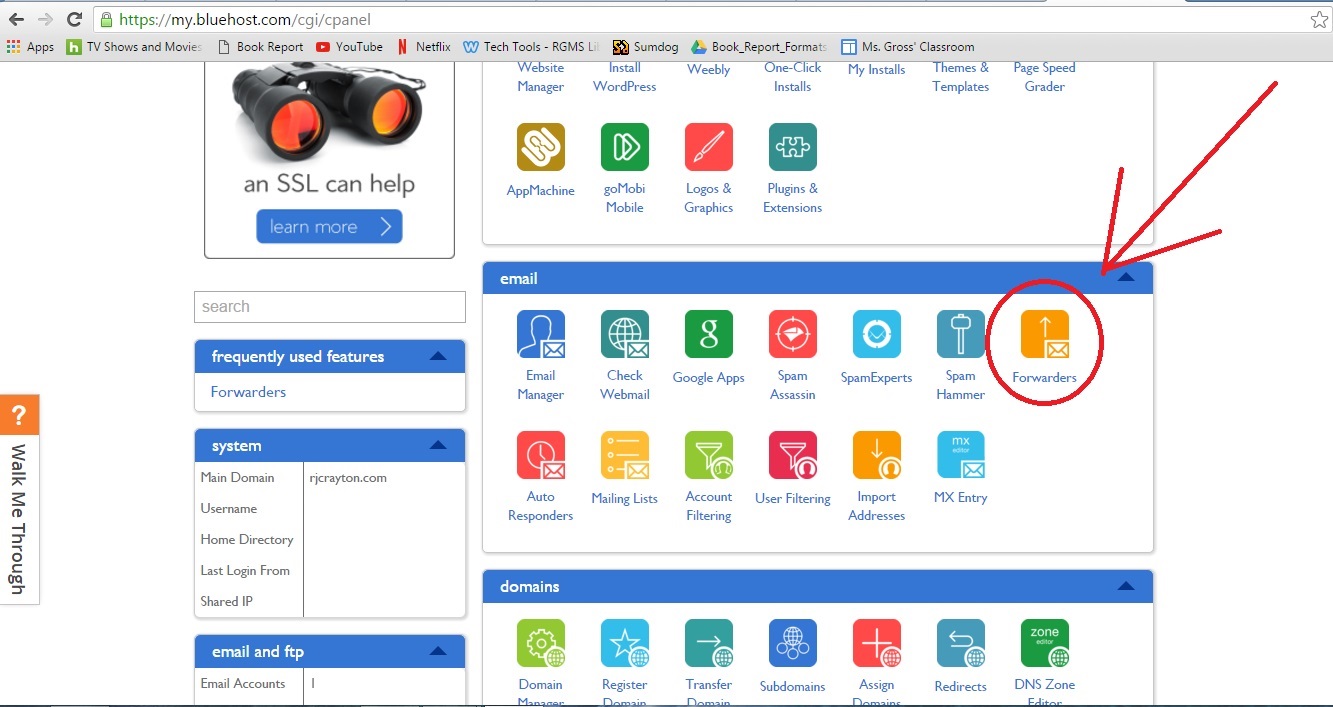 Did you get your own domain name for your website, but never bothered to add an email address to go with that domain? Well, some changes at the big free email services may just be the push you needed to get a custom email address forwarder set up.
Did you get your own domain name for your website, but never bothered to add an email address to go with that domain? Well, some changes at the big free email services may just be the push you needed to get a custom email address forwarder set up.
Authors often use mailing services for their newsletters. Now, mail services like MailChimp are pushing authors to not use free services like Yahoo and Gmail for the return address.

Instead, they’d like you to use a custom domain address (such as [email protected]). Why? MailChimp explains in detail here. A brief explanation is that when you tell your mail service to use Yahoo as your outgoing email address, they pretend as if they’re sending the email from your Yahoo address (with your permission). Yahoo has decided they don’t want people pretending to send emails from them, and are blocking spoofed addresses. Therefore anyone you send to with a Yahoo address won’t get your email. Other email services are planning to adopt similar policies, and mailing list services want your emails to go through.
The good news is, if you own your own domain name you can easily set up an “email forwarder” so you have an email address at your domain name. While you could set up another email account, you would also have to check that account for incoming emails if you did. A forwarder is nice because there is no actual mailbox associated with it. When a message is sent to a “forwarder” email address, the message is simply routed to you at the address of your choice. So, generally, you set up your forwarder to forward mail to the inbox you check most often. If your email address is [email protected], you can create a forward to [email protected] to forward to your Gmail address.
Setting up a forwarder is simple. If you are hosted by a hosting company, go to your dashboard and look for email forwarders. It should look like this:  Click on Forwarders. If you don’t have a specific item called forwarders, click on Email and then look for a Forwarders options. Then click on the option that allows you to ADD a forwarder. You should get a screen that looks something like this:
Click on Forwarders. If you don’t have a specific item called forwarders, click on Email and then look for a Forwarders options. Then click on the option that allows you to ADD a forwarder. You should get a screen that looks something like this:  In the top box, you’ll enter the first part of your new forwarded email address. So in that top box, I can put ImSoCool for the email address name ([email protected] is nice, yes?). In the lower box, you’ll put the email address you want your email sent to. Then, click the Submit button, and your email forwarder will be set up.
In the top box, you’ll enter the first part of your new forwarded email address. So in that top box, I can put ImSoCool for the email address name ([email protected] is nice, yes?). In the lower box, you’ll put the email address you want your email sent to. Then, click the Submit button, and your email forwarder will be set up.
If you started with a free WordPress site and paid for your own domain name, still hosted free by WordPress, your domain fee includes 5 email address forwarders. To add forwarders on WordPress, go to your Dashboard and on the side, go to Store, then Domains.  Click the arrow next to your paid domain name. Scroll down and click on EMAIL. Under the email tab, it should allow you to add up to 5 email forwarders. The screen you fill out should look similar to the one for outside hosted sites. Simply fill in the appropriate boxes and you’ll have your email forwarder created.
Click the arrow next to your paid domain name. Scroll down and click on EMAIL. Under the email tab, it should allow you to add up to 5 email forwarders. The screen you fill out should look similar to the one for outside hosted sites. Simply fill in the appropriate boxes and you’ll have your email forwarder created.
Now, you’re saying to yourself: Hey, what if I want to respond to these messages from that email address? It’s not a real address. It can only receive forwarded mail. True. But, generally, Gmail, Yahoo, and other mail services allow you to spoof your own address. That means, you can send out an email that says it’s from [email protected], even though you’re sending it from your [email protected] address. Here are instructions for this on Gmail, Yahoo, and Hotmail. Now that you’ve got that taken care of, you’re good to go. Happy mailing.

Awesome. Thank you, RJ! Bookmarking for when I start a new website.
You’re welcome. Hope it helps when you get to your new site.
It’s also perceived as more professional to have actually paid money for your own URL. If you can use the method RJ described in the last paragraph to scam everyone into thinking you paid when you didn’t, then you’re accomplished enough that it doesn’t matter 🙂
Well, you actually have to have bought the domain name (which is as cheap as $12 a year), but you don’t have to pay to have it hosted. And that’s really where the expense is. But, responding from your forwarder address looks more professional.
I find this confusing: I work alone and do not have a street team to help me, nor an assistant to answer my emails, why forward and funnel different emails from my different email accounts into one email account. Doesn’t this defeat the purpose of setting up more than one email account for a specific series or newsletter, or offer, or for the different author names I use? If I reply from a forwarded email address, or a different name how does my customer know it is really from me? And not a spammer? Especially, if they are looking for a reply from the original email address they sent their e-mail to?
Please advise.
Thank you,
Joe
I’m sorry I wasn’t more clear. Let me try to answer your questions.
1. why forward and funnel different emails from my different email accounts into one email account?
If you actually have an email account at your domain name, then this article really isn’t for you. The goal of this article was to explain how to create a forwarder at your domain name if you don’t already have one. I indicated above the reasons why you might want one. If you have purchased a domain name at a FREE WordPress account, you can only set up a forwarder, not an actual email address. I suggested using a forwarder if you still plan to use your free mail account (gmail, yahoo, etc) for most of your mailing needs. This means you do not have to check several different email accounts to access all your mail. For some people, it’s easier to check everything from the single account they’re most active on (and one they can access from their phone).
If I reply from a forwarded email address, or a different name how does my customer know it is really from me?
Your customer wouldn’t know IF you did that. However, I said YOU SHOULD NOT DO THAT. I said you should get your free mail service (gmail, yahoo, etc) to spoof your forwarded address. When you respond to that email from your gmail account, it will tell the recipient the email is coming from [email protected]. I linked to instructions explaining how to get your free mail account to spoof your address, so it appeared that you were sending your email from the forwarded address. This is your only option if you’ve paid for a domain name but have free hosting at a place like WordPress. If you pay to host your domain name, your fee should cover email accounts. You can actually create an email address with that name, login and respond from that account. That just adds another layer, when having your freemail spoof the address works fine for most people. For example, when I go to my gmail and get ready to send an email, the From field is a drop down box. I get to pick the email address I want to send from. When I send the email, I can send it from the gmail address or an rjcayton.com address. Gmail will only spoof an address after you prove you own it, so you do have to set up the forwarder before you can request a spoof.
Now, if you use a spoofed email address, a person who chooses to view the header path can see where the email actually came from, but most people don’t go find the header path unless they’ve got some type of problem with the email.
I hope this helps.
Hi RJ,
Thank you very much for clearing this up for me, now I understand what you are doing and why. … and it does not apply to what I am doing. LoL
Take care,
Joe W
very usefull…thank you for the article…
Thanks for the tips, RJ. I totally get the reason forwarders are needed was eager to try your ideas as an Indie author on Weebly using MailChimp for monthly newsletters. However, I got bogged down on the tech side with gmail, not seeing a forwarder option but presented with creating an ‘alias’ and these instructions from gmail: “Enter the SMTP server (e.g. smtp.domain.com), your username on that domain, and your password for that account. You may also need to adjust your port setting or SSL setting (talk to your other ISP if you need this information).” Cross-eyed at this point and hating the idea of spending $4 monthly to have my own domain name email address in order to send my newsletters. Even though it’s more professional, I’m a cash-strapped Indie.